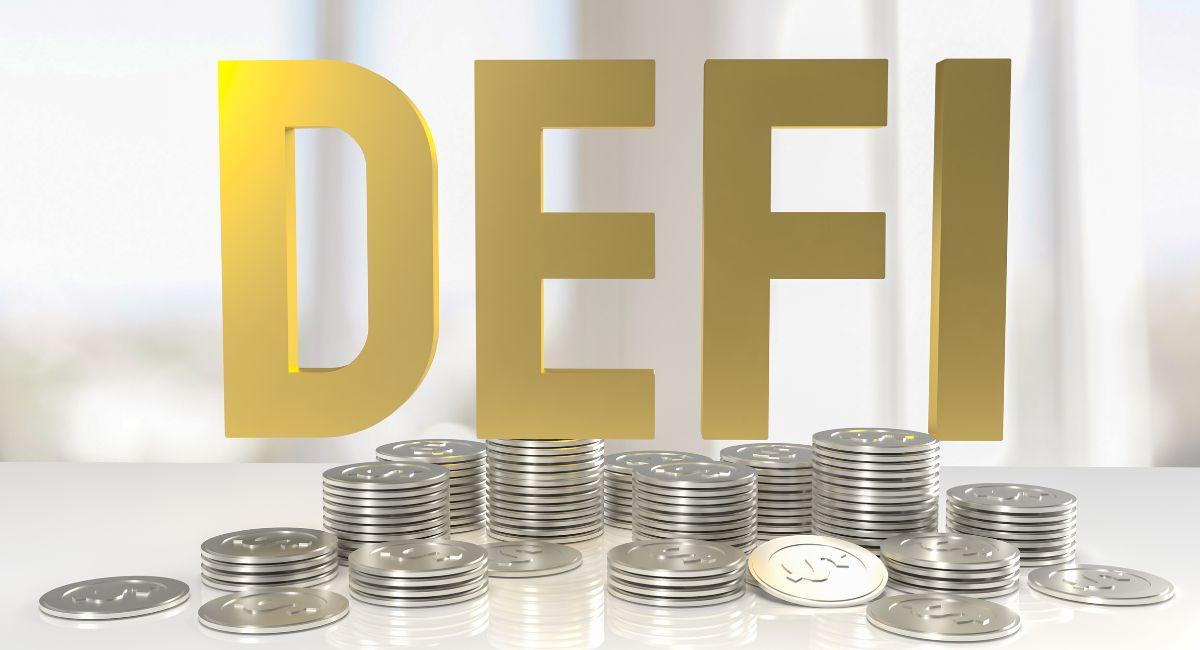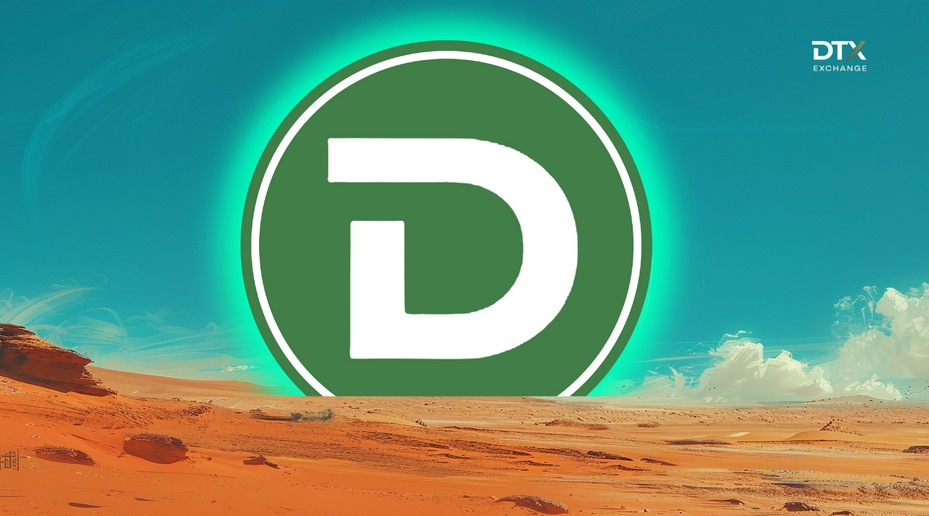DeFi
Top 5 Intriguing Ways RWATs (Real-World Asset Tokens) Can Stabilize DeFi

Decentralized Finance (DeFi) has revolutionized the financial landscape, offering innovative lending, borrowing, and trading opportunities. However, DeFi currently faces a significant challenge – volatility. The value of DeFi assets, primarily cryptocurrencies, can fluctuate dramatically, leading to potential risks for users. Here’s how real-world asset tokens (RWATs) can act as a stabilizing force in the DeFi
Decentralized Finance (DeFi) has revolutionized the financial landscape, offering innovative lending, borrowing, and trading opportunities. However, DeFi currently faces a significant challenge – volatility. The value of DeFi assets, primarily cryptocurrencies, can fluctuate dramatically, leading to potential risks for users. Here’s how real-world asset tokens (RWATs) can act as a stabilizing force in the DeFi ecosystem.
The Volatility Challenge in DeFi
DeFi protocols are often built on native tokens or other cryptocurrencies. While these offer decentralization and innovation, their inherent volatility can lead to:
-
Liquidation Risks: In lending protocols, sudden price drops can trigger loan liquidations, forcing users to sell their assets at a loss.
-
Investor Uncertainty: High volatility discourages some traditional investors from entering the DeFi space, hindering its overall growth and adoption.
-
Market Manipulation: Volatile markets are more susceptible to manipulation by large holders, posing a risk to smaller investors.
Unveiling the Potential: A Deep Dive into Real-World Asset Tokens (RWATs)
The world of finance is on the cusp of a transformative era, fueled by the innovative power of blockchain technology. Enter Real-World Asset Tokens (RWATs), a revolutionary concept that bridges the gap between traditional assets and the decentralized world of cryptocurrency. Let’s delve deeper into this exciting realm, exploring the intricacies of RWATs and their potential to reshape the financial landscape.
At its core, an RWAT represents a digital claim on a real-world asset. This asset can be tangible, like real estate, artwork, or commodities, or intangible, like intellectual property or even a fraction of a company. Imagine a piece of valuable artwork owned by a gallery. Through tokenization, this artwork can be represented by RWATs, essentially creating digital units of ownership that can be traded on a blockchain platform.
Unlocking New Possibilities: The Benefits of RWATs
The tokenization of real-world assets offers a myriad of benefits for both asset owners and investors:
- Increased Liquidity: Traditionally illiquid assets like real estate or fine art become more accessible through RWATs. Imagine a high-value property that would typically require a large sum of money to invest in. By tokenizing the property, it can be divided into smaller, more manageable RWATs, allowing a wider pool of investors to participate.
- Fractional Ownership: RWATs enable fractional ownership of assets, allowing individuals to invest in previously inaccessible assets. Imagine a high-priced piece of intellectual property. By tokenizing it, investors can purchase smaller fractions of ownership, spreading the investment cost and democratizing access to valuable assets.
- Enhanced Efficiency: The use of blockchain technology streamlines processes associated with asset ownership and transfer. Imagine the cumbersome paperwork and legal fees involved in selling a piece of real estate. RWATs eliminate these inefficiencies by creating a secure and transparent record of ownership on a blockchain, facilitating faster and cheaper transactions.
- Global Investment Opportunities: RWATs open doors to a global investor base. Imagine a piece of real estate in a remote location. By tokenizing it, investors from all over the world can participate in the ownership, eliminating geographical restrictions and fostering a more inclusive investment landscape.
- Programmable Features: Smart contracts, self-executing contracts on the blockchain, can be attached to RWATs, enabling features like automated dividend distribution or voting rights for token holders. Imagine owning RWATs representing a company. Smart contracts could be programmed to automatically distribute a portion of the company’s profits to token holders at predetermined intervals.
Top 5 Intriguing Ways Real-World Asset Tokens (RWATs) Can Stabilize DeFi: Building Bridges of Stability
The world of Decentralized Finance (DeFi) pulsates with innovation and disruption. However, the inherent volatility of cryptocurrencies poses a significant challenge to mainstream adoption. Enter Real-World Asset Tokens (RWATs) – a potential game-changer that can introduce stability and broaden the horizons of the DeFi ecosystem. Here’s a deep dive into the top 5 intriguing ways RWATs can stabilize DeFi:
1. From Crypto Rollercoaster to Stable Shores: Diversification Through Real-World Assets
DeFi currently relies heavily on crypto-native assets, exposing users to the volatile swings of the cryptocurrency market. RWATs, representing real-world assets like real estate, commodities, or even precious metals, offer a diversification opportunity. Imagine a DeFi user with a portfolio solely invested in cryptocurrencies. By incorporating RWATs, they can diversify their holdings with assets that exhibit lower volatility, potentially mitigating overall portfolio risk and creating a more stable investment environment.
2. Harnessing Collateralized Stability: Unlocking Borrowing Power with RWATs
RWATs can act as collateral for loans within DeFi protocols. Imagine a user holding RWATs representing a piece of real estate. They could use these tokens as collateral to borrow a stablecoin on a DeFi platform, unlocking additional liquidity without selling the underlying asset. This injects stability into the system by creating a more diverse pool of collateral options for borrowers, potentially leading to more stable interest rates and borrowing terms.
3. Bridging the Gap to Traditional Finance: Attracting Institutional Investors with Stability
The volatility of cryptocurrencies discourages many institutional investors from entering the DeFi space. However, RWATs offer a bridge between the two worlds. Assets like tokenized real estate or commodities offer a level of familiarity and stability that can attract institutional investors. This influx of capital can bring greater liquidity and stability to DeFi protocols, benefiting all participants. Imagine a large investment firm hesitant to invest in DeFi due to the volatility. By incorporating RWATs, DeFi becomes a more attractive investment proposition, fostering growth and stability within the ecosystem.
4. Innovation Through Hybrid Stablecoins: RWAT-Backed Stability with Crypto Agility
RWATs can be used to create innovative hybrid stablecoins. Imagine a stablecoin pegged to the value of a basket of RWATs, such as real estate and precious metals. This stablecoin would benefit from the stability of real-world assets while retaining the fungibility and transferability characteristics of cryptocurrencies. These hybrid stablecoins can introduce more stability to DeFi by offering users a reliable store of value within the ecosystem, potentially mitigating the impact of market fluctuations.
5. Unlocking New Investment Opportunities: Structured Products with Reduced Risk
The integration of RWATs opens doors for the creation of structured products within DeFi. These products can offer various risk-return profiles, catering to a wider range of investors. Imagine a DeFi platform offering investment products that combine RWATs with cryptocurrencies, allowing users to create customized portfolios with varying levels of risk and potential returns. This innovation can attract new investors seeking stability and potentially lead to a more mature and diversified DeFi ecosystem.
Also, read – Top 10 Amazing Potential of Real-World Assets in DeFi: Clearing All The Hype vs. Reality
Challenges and Considerations: Navigating the Evolving Landscape of RWATs for DeFi Stability

While Real-World Asset Tokens (RWATs) offer a compelling vision for stabilizing DeFi, there are significant challenges to consider before they can fully realize their potential. Here’s a closer look at the key hurdles that need to be addressed:
1. Regulatory Uncertainty: A Labyrinth of Legal Frameworks
The regulatory landscape surrounding RWATs remains murky. Governments are still grappling with how to classify and regulate these new financial instruments. This uncertainty creates a barrier for traditional financial institutions hesitant to enter the DeFi space due to potential regulatory compliance issues. Imagine a large bank considering offering RWAT-based services on a DeFi platform. Without clear regulations, they might be hesitant to move forward, hindering the integration of traditional finance and DeFi.
2. Valuation Hurdles: Determining the True Worth of RWATs
Accurately valuing RWATs, particularly those representing unique or illiquid assets like fine art or private equity, can be complex. Unlike publicly traded stocks with readily available market data, RWAT valuation often relies on appraisals or subjective assessments. This lack of a standardized and transparent valuation process can create uncertainty for investors and potentially lead to market inefficiencies within DeFi.
3. Security Concerns: Bridging the Gap Between Physical and Digital
Ensuring the security of both the underlying real-world assets and the blockchain platform where RWATs reside is paramount. Imagine a scenario where a security breach compromises the digital representation of a real-world asset on the blockchain. This could lead to a loss of investor confidence and disrupt the stability of DeFi protocols. Robust security measures are crucial to foster trust and mitigate the risks associated with bridging the physical and digital worlds through RWATs.
4. Liquidity Challenges: Creating Deep and Active Markets
While RWATs aim to improve asset liquidity, creating a deep and active market for all tokenized assets can be difficult. Imagine a DeFi platform offering RWATs representing a niche asset class like vintage cars. If the trading volume for these RWATs is low, it can be challenging for users to enter or exit their positions quickly, potentially hindering the overall liquidity of the DeFi ecosystem.
5. Counterparty Risk: The Importance of Trustworthy Custodians
When RWATs represent physical assets, there’s a need for secure and reliable custodians to safeguard the underlying assets. Imagine a scenario where the custodian responsible for storing a piece of real estate represented by RWATs goes bankrupt or mismanages the asset. This can lead to significant losses for investors and erode trust in the RWAT ecosystem. Careful selection and rigorous oversight of custodians are essential to mitigate counterparty risk and ensure the stability of RWATs within DeFi.
A Collaborative Effort for a Stable Future
Despite the challenges, RWATs hold immense potential to usher in a new era of stability and growth for DeFi. By addressing the regulatory hurdles, developing standardized valuation methods, implementing robust security measures, fostering deeper liquidity, and ensuring reliable custodianship, RWATs can truly become the bridge between the traditional and decentralized financial worlds. This requires a collaborative effort from governments, regulators, DeFi developers, and traditional financial institutions. By working together, we can navigate these challenges and unlock the transformative potential of RWATs, paving the way for a more stable and inclusive DeFi ecosystem.
The Road Ahead: A Collaborative Path to DeFi Stability with RWATs
The potential for Real-World Asset Tokens (RWATs) to revolutionize DeFi by introducing stability and attracting new participants is undeniable. However, as we’ve explored, there are significant challenges that need to be addressed. Here’s a roadmap outlining a collaborative approach to navigate these hurdles and pave the way for a more stable DeFi future with RWATs:
1. Building Bridges with Regulators: Fostering Open Dialogue
- Industry Initiatives: DeFi developers and blockchain companies can work together to establish industry standards for RWAT creation, trading, and custody.
- Regulatory Clarity: Engaging in open dialogue with regulatory bodies to advocate for clear and comprehensive regulations for RWATs, fostering innovation while mitigating potential risks.
- Pilot Programs: Collaborating with regulators on pilot programs that explore the use of RWATs in a controlled environment, providing valuable data to inform future regulations.
2. Standardization for Stability: Creating a Unified Approach
- Valuation Frameworks: Developing standardized valuation methodologies for RWATs based on asset class, ensuring transparency and fair market pricing within DeFi.
- Data Sharing and Transparency: Encouraging collaboration between DeFi platforms and traditional financial institutions to share relevant data and create a more holistic view of RWAT valuation.
- Independent Audits: Regular independent audits of RWAT platforms and custodians to ensure the security and integrity of the underlying assets and the blockchain infrastructure.
3. Security by Design: Building Trustworthy Infrastructure
- Blockchain Security: Leveraging cutting-edge blockchain security protocols and conducting regular penetration testing to identify and address potential vulnerabilities.
- Smart Contract Audits: Rigorous audits of smart contracts associated with RWATs to minimize the risk of bugs or exploits that could compromise user funds.
- Decentralized Custody Solutions: Exploring decentralized custodian models that leverage blockchain technology to enhance security and transparency while mitigating counterparty risk.
4. Liquidity Innovation: Building Deep and Active Markets
- Market Makers: Incentivizing market makers to provide liquidity for RWATs, especially for those representing less common asset classes.
- Secondary Market Integration: Exploring integration with secondary markets for traditional assets, allowing DeFi users to benefit from existing liquidity pools.
- Fractionalization Strategies: Strategically fractionalizing RWATs to make them more accessible to a wider range of investors, potentially increasing trading volume and liquidity.
5. Collaboration is Key: A Multi-Stakeholder Approach
- DeFi-Traditional Finance Partnerships: Encouraging partnerships between DeFi platforms and traditional financial institutions to leverage their expertise in asset custody, valuation, and risk management.
- Academia and Research: Fostering collaboration between academia and the DeFi industry to conduct research on RWATs and their impact on the financial landscape.
- Community Building: Building a strong and inclusive DeFi community that actively participates in discussions and developments surrounding RWATs.
Conclusion: A Brighter Future for DeFi
By embracing these collaborative strategies, we can unlock the true potential of RWATs to stabilize DeFi and usher in a new era of financial inclusion and opportunity. With clear regulations, standardized practices, robust security measures, and deeper liquidity, RWATs can bridge the gap between traditional and decentralized finance, creating a more stable and accessible financial system for all. The road ahead requires dedication and collaboration, but the potential rewards are immense. By working together, we can transform DeFi into a powerful engine for financial innovation and empowerment, with RWATs serving as the cornerstone of a more stable and inclusive financial future.
DeFi
Cryptocurrency and defi firms lost $266 million to hackers in July

In July 2024, the cryptocurrency industry suffered a series of devastating attacks, resulting in losses amounting to approximately $266 million.
Blockchain Research Firm Peck Shield revealed in an X post On August 1, attacks on decentralized protocols in July reached $266 million, a 51% increase from $176 million reported in June.
The most significant breach last month involved WazirX, one of India’s largest cryptocurrency exchanges, which lost $230 million in what appears to be a highly sophisticated attack by North Korean hackers. The attack was a major blow to the stock market, leading to a break in withdrawals. Subsequently, WazirX launched a program in order to recover the funds.
Another notable incident involved Compound Finance, a decentralized lending protocol, which suffered a governance attack by a group known as the “Golden Boys,” who passed a proposal who allocated 499,000 COMP tokens – valued at $24 million – to a vault under their control.
The cross-chain liquidity aggregation protocol LI.FI also fell victim On July 16, a hack resulted in losses of $9.73 million. Additionally, Bittensor, a decentralized machine learning network, was one of the first protocols to suffer an exploit last month, loming $8 million on July 3 due to an attack targeting its staking mechanism.
Meanwhile, Rho Markets, a lending protocol, suffered a $7.6 million breach. However, in an interesting twist, the exploiters research to return the stolen funds, claiming the incident was not a hack.
July 31, reports The Terra blockchain protocol was also hacked, resulting in a loss of $6.8 million across multiple cryptocurrencies. As crypto.news reported, the attack exploited a reentrancy vulnerability that had been identified a few months ago.
Dough Finance, a liquidity protocol, lost $1.8 million in Ethereum (ETH) and USD Coin (USDC) to a flash loan attack on July 12. Similarly, Minterest, a lending and borrowing protocol, saw a loss of $1.4 million due to exchange rate manipulation in one of its markets.
Decentralized staking platform MonoSwap also reported a loss of $1.3 million following an attack that allowed the perpetrators to withdraw the liquidity staked on the protocol. Finally, Delta Prime, another decentralized finance platform, suffered a $1 million breach, although $900,000 of the stolen funds was later recovered.
DeFi
Centralized crypto exchanges are slowly losing ground to their DeFi counterparts

Centralized crypto exchanges are slowly losing ground to their DeFi counterparts, according to an in-depth data analysis conducted by Decrypt.
DeFiLlama’s decentralized exchange (DEX) volume data and CoinGecko’s total cryptocurrency trading volume data show that the percentage of cryptocurrency trading volume occurring on DEXs relative to total trading volume has increased from 4.6% in February to over 7% this month. This is an increase in the share of trading volume driven by DEXs of over 52%.
Source: Adrian Zmudzinski
Kunal Goel, a senior research analyst at Messari, told Decrypt that several factors are fueling the growth in DEX market share. He cited “the growth of meme coins and long-tail assets” as one of the reasons, explaining that they tend to list first on DEXs and only appear on centralized exchanges much later.if they last that long.
“The onchain user experience has improved with low fees and high throughput on Solana and Ethereum L2,” he added, highlighting advancements making decentralized finance (DeFi) solutions increasingly easier to use.
DeFiLlama data further shows that over the past 24 hours, DEX volume accounted for 22% of total trading volume. The crypto price aggregator notes that this percentage is meant to represent the dominance of decentralized exchanges over aggregated decentralized exchanges and centralized exchanges.
So far in 2024, DEX volume has seen a slow and steady increase.
CEX and DEX trading volume increased from $133.5 billion in January to $179.5 billion this month, an increase of about 34%. The year-to-date high was recorded in March, when CEX and DEX volumes saw a sharp increase, reaching $4.8 trillion and $266.89 billion, respectively.
Goel noted that at the time, “Bitcoin hit new all-time highs in March and trading activity is generally positively correlated with price and sentiment.” Looking ahead, he expects centralized exchanges to move on-chain and disrupt their own business models before others can. He added that “Base and BNB Chain are the most prominent examples of this.”
TradingView also shows a DeFi market cap dominance chart, in percentage terms. Currently at 3.86%, it fell from 4.47% on January 1 and hit a 2024 high of 4.81% on February 25. Goel noted that this was unexpected since “DEX volumes are a key driver of DEX value, so it’s a bit contradictory.”
Challenge is an umbrella term for a group of financial tools built on a blockchain, including DEXs, exchanges that operate primarily on-chain. The primary goal of DeFi is to allow anyone with internet access to lend, borrow, and bank without relying on intermediaries.
Similarly, the main goal of DEXs is to allow anyone with internet access to trade or even provide liquidity in exchange for a stake. DeFi and DEXs are one of the main areas of focus in decentralized application (dapp) development, which have seen considerable adoption this year.
Edited by Stacy Elliott.
DeFi
Pump.Fun Overtakes Ethereum in Daily Revenue: A New Leader in DeFi

In a remarkable turn of events, Pump.Fun, a memecoin launchpad, has surpassed all other platforms in the decentralized finance (DeFi) sector, achieving the highest gross revenue in the last 24 hours. According to data from DeFiLlama, Pump.Fun amassed $867,429 during this period, surpassing Ethereum’s $844,276. This achievement underscores the growing influence of memecoin infrastructure within DeFi.
Pump.Fun Revenue Milestones
The impressive revenue numbers go beyond daily performance. Pump.Fun is generating $315 million in annualized revenue, averaging $906,160 per day over the past week. This revenue surge is largely due to the recent memecoin frenzy, with Solana-based memecoins being particularly popular among on-chain enthusiasts. The platform’s user-friendly interface allows non-technical users to quickly launch their own tokens, spending as little as $2 without needing to provide any initial liquidity.
How Pump.Fun works
Pump.Fun’s operating model is designed to facilitate the use and rapid launch of tokens. Users can create new tokens in minutes, which are then allowed to trade along a bonding curve until they reach a market cap of approximately $75,000. At this point, the bonding curve is burned on Raydium, establishing a secure liquidity pool. The platform generates revenue through a 1% fee on transactions made on the platform. However, once a token is bonded and burned on Raydium, Pump.Fun stops charging this fee.
Ethereum: Traditional Power
Despite its daily revenues, Ethereum remains a cornerstone of the DeFi ecosystem. It is the blockchain of Ether, the second-largest cryptocurrency with a market cap of $395 billion. Ethereum powers many applications and digital assets, backing over $60 billion worth of smart contracts. Revenue generation on Ethereum is done through transaction fees, called gas, which are paid in ETH for executing transactions and smart contracts.
Comparative analysis of revenue models
While Ethereum’s revenue model relies on gas fees for transactions and smart contract executions, Pump.Fun takes a different approach. By enabling easy and low-cost token launches, Pump.Fun caters to a broad audience, including non-technical users. This inclusiveness, combined with the excitement surrounding memecoins, has led to rapid revenue growth. The 1% transaction fee ensures continued revenue generation until the token transitions to Raydium, creating a sustainable business model.
Memecoin frenzy
The recent rise in popularity of memecoins has been a major contributor to Pump.Fun’s success. Memecoins, particularly those based on Solana, have captivated the DeFi community, generating substantial activity on platforms like Pump.Fun. This trend highlights a shift in DeFi dynamics, where niche platforms catering to specific interests can achieve significant revenue milestones.
Future prospects
Pump.Fun’s recent successes suggest a potential shift in the DeFi landscape. As the platform continues to attract users with its simple token launch process and low-cost entry point, it could solidify its position as a leader in the DeFi space. The memecoin phenomenon shows no signs of slowing down, indicating that platforms like Pump.Fun could continue to see robust growth.
In conclusion, Pump.Fun’s ability to surpass Ethereum in terms of daily revenue underscores the evolving nature of the DeFi space. By providing a user-friendly platform for launching memecoins, Pump.Fun has tapped into a lucrative niche, demonstrating the potential for niche platforms to thrive alongside traditional blockchain giants like Ethereum. This development signals a broader trend toward diversification and innovation within the DeFi ecosystem, with new entrants challenging established players through unique value propositions and targeted services.
DeFi
$10 Billion Venture Firm May Target 10x Opportunities in Ripple (XRP) and This DeFi Token

According to recent reports, one of the largest venture capital firms is looking for new opportunities in the cryptocurrency space as Bitcoin (BTC) attempts to break its all-time high and start a new bull run in the cryptocurrency market. They are balancing risk with low-risk, low-reward and high-risk, high-reward opportunities.
The first investment candidate is a top cryptocurrency, Ripple (XRP); it doesn’t have much growth potential because it’s already a large cap. Another scenario the firm is targeting is DTX ExchangeThe new hybrid exchange is expected to revolutionize the foreign exchange industry. According to analysts, its growth potential is immense and the risk is also very limited due to its low price.
Market is bullish as Trump wants to make US a Bitcoin (BTC) superpower
Over the past 30 days, Bitcoin (BTC) has increased by about 10%, and one of the catalysts for this price increase has been Donald Trump recently speaking out as a crypto pro. Presidential candidate Donald Trump has promised to make the United States the world leader in cryptocurrencies if elected in November. Speaking at the Bitcoin2024 conference in Nashville, Trump compared Bitcoin (BTC) to the steel industry of 100 years ago, highlighting its potential.
Trump’s plans include firing SEC Chairman Gary Gensler and immediately creating a “Presidential Advisory Council on Bitcoin (BTC) and Cryptocurrencies.” He stressed the importance of American leadership in the cryptocurrency space, saying, “I am laying out my plan to ensure that the United States is the cryptocurrency capital of the planet and the Bitcoin (BTC) superpower of the world.”
$600 Million Worth of Ripple (XRP) to Be Released in August
Ripple (XRP), the company behind the XRP Ledger blockchain and its native token Ripple (XRP), unlocks up to 1 billion tokens on the first day of every month. Since 2017, they have used several major escrow wallets, including Ripple (XRP) (24) and Ripple (XRP) (25), to evenly distribute these monthly unlocks.
However, Ripple (XRP) often relocks a large portion of newly issued XRP. For example, on June 1, Ripple (XRP) relocked 800 million XRP but still sold about 300 million XRP, worth $182 million at the time.
While Ripple (XRP) releases up to 1 billion XRP tokens each month, the actual amount released into circulation is typically much lower due to this re-escrow process, as noted in a 2017 XRP Ledger blog post.
DTX Exchange Follows Bitcoin (BTC) Path
The main target of large private equity firms is the DTX exchange (DTX), the reason being a clearly high utility like Bitcoin (BTC). This project has attracted global attention thanks to its exceptional pre-sale performance, offering early buyers a 100% return on investment and raising over $1 million. Projections suggest that this figure will reach $2 million by the end of August 2024.
DTX Exchange offers a revolutionary hybrid trading platform, combining the best features of centralized (CEX) and decentralized (DEX) exchanges. Traders can enjoy a seamless experience with access to over 120,000 asset classes, no KYC verification upon registration and ultra-fast transaction speeds of 0.04 seconds.
These benefits have attracted traders to this new cryptocurrency exchange. Currently, in Phase 2 of its pre-sale, DTX Exchange is listed at $0.04, which is double its starting price of $0.02. Market analysts predict that the upcoming listing of DTX Exchange on the Level 1 CEX in late 2024 could trigger a 100x bullish rally, making DTX Exchange the top cryptocurrency exchange to watch.
Learn more:
Disclaimer: The statements, views and opinions expressed in this article are solely those of the content provider and do not necessarily represent those of Crypto Reporter. Crypto Reporter is not responsible for the reliability, quality and accuracy of the materials contained in this article. This article is provided for educational purposes only. Crypto Reporter is not responsible or liable, directly or indirectly, for any damage or loss caused or alleged to be caused by or in connection with the use of or reliance on any content, goods or services mentioned in this article. Do your research and invest at your own risk.
-

 Videos12 months ago
Videos12 months agoCrypto News: Bitcoin, ETH Price, CPI Print, PYTH, WIF & MORE!!
-

 Videos11 months ago
Videos11 months agoCrypto News: Bitcoin Price, ETF, ETH, WIF, HNT & MORE!!
-

 DeFi11 months ago
DeFi11 months agoMetasphere Labs announces follow-up event regarding
-

 Videos12 months ago
Videos12 months agoSolana price potential?! Check out THIS update if you own SOL!!
-

 DeFi8 months ago
DeFi8 months agoPump.Fun Overtakes Ethereum in Daily Revenue: A New Leader in DeFi
-

 DeFi8 months ago
DeFi8 months agoDegens Can Now Create Memecoins From Tweets
-

 News8 months ago
News8 months agoNew bill pushes Department of Veterans Affairs to examine how blockchain can improve its work
-

 News8 months ago
News8 months agoLawmakers, regulators to study impact of blockchain and cryptocurrency in Alabama • Alabama Reflector
-

 Bitcoin8 months ago
Bitcoin8 months ago1 Top Cryptocurrency That Could Surge Over 4,300%, According to This Wall Street Firm
-

 Videos11 months ago
Videos11 months agoWho Really CONTROLS THE MARKETS!! Her plans REVEALED!!
-

 Ethereum11 months ago
Ethereum11 months agoComment deux frères auraient dérobé 25 millions de dollars lors d’un braquage d’Ethereum de 12 secondes • The Register
-

 Videos11 months ago
Videos11 months agoCryptocurrency News: BTC Rally, ETH, SOL, FTM, USDT Recover & MORE!





